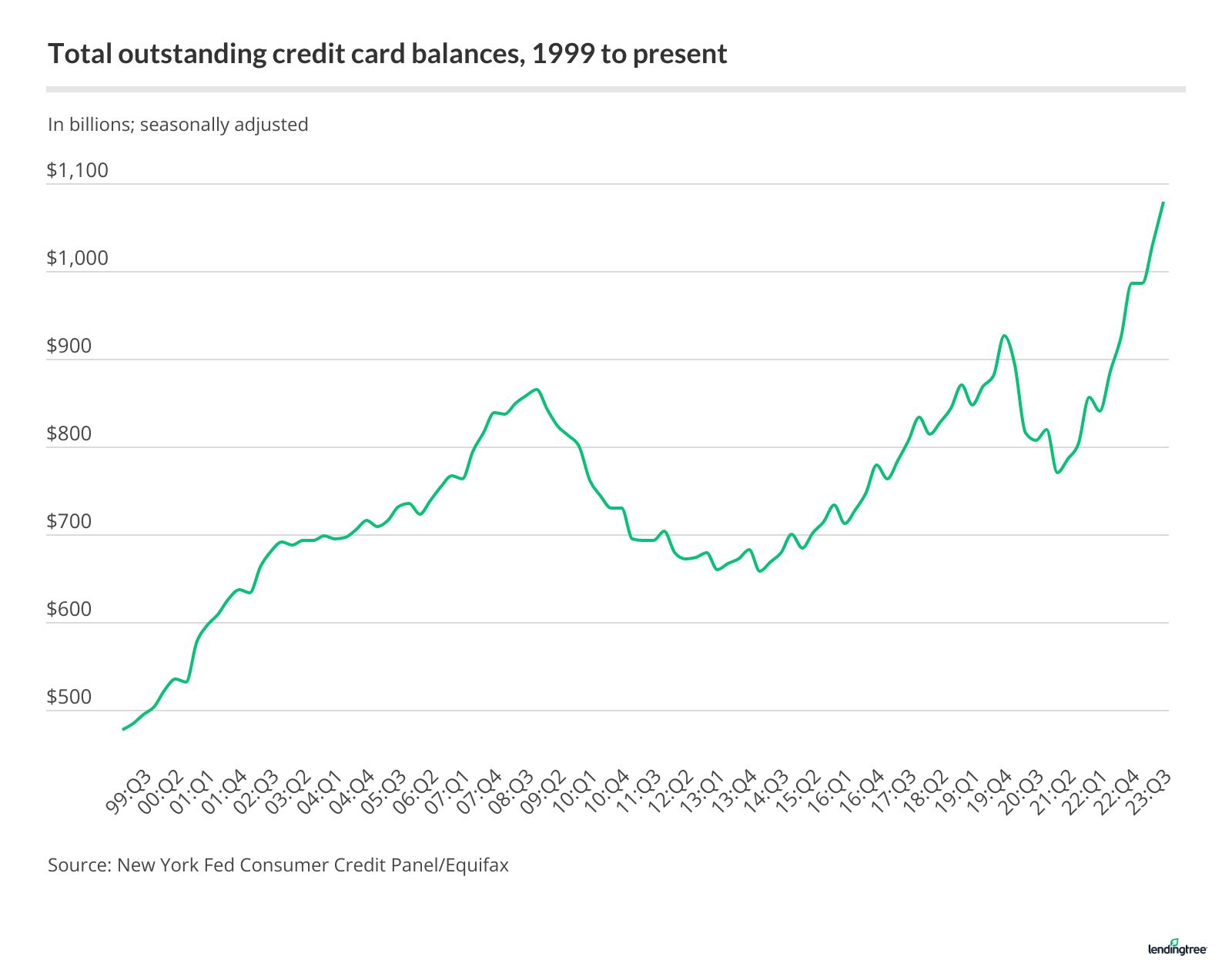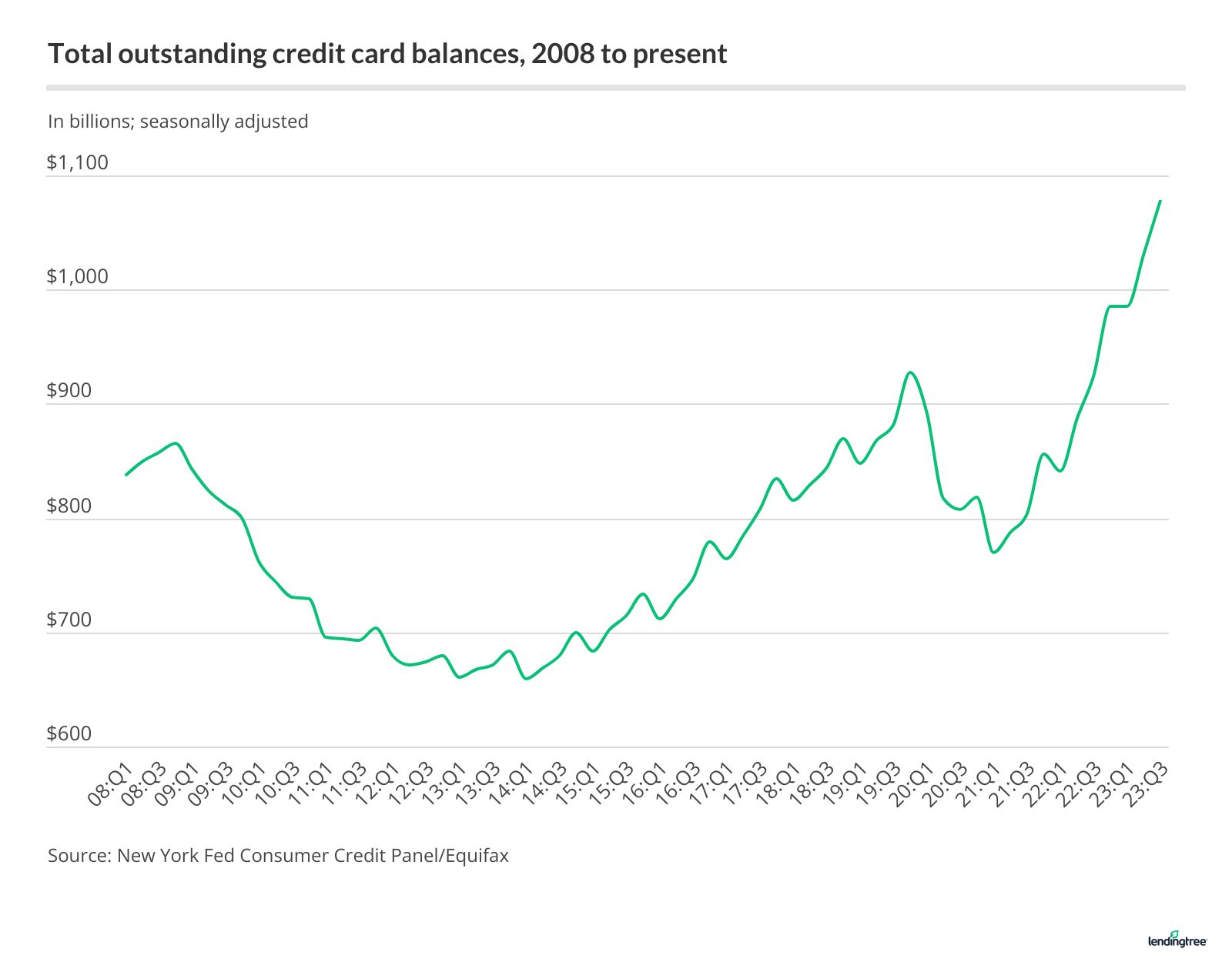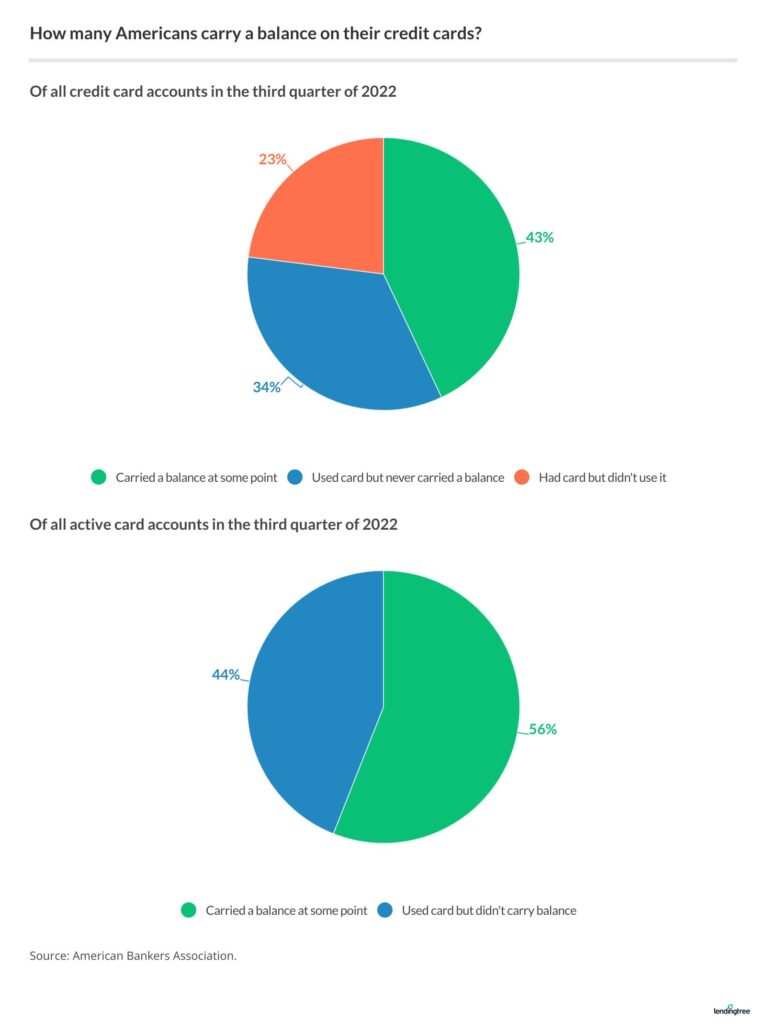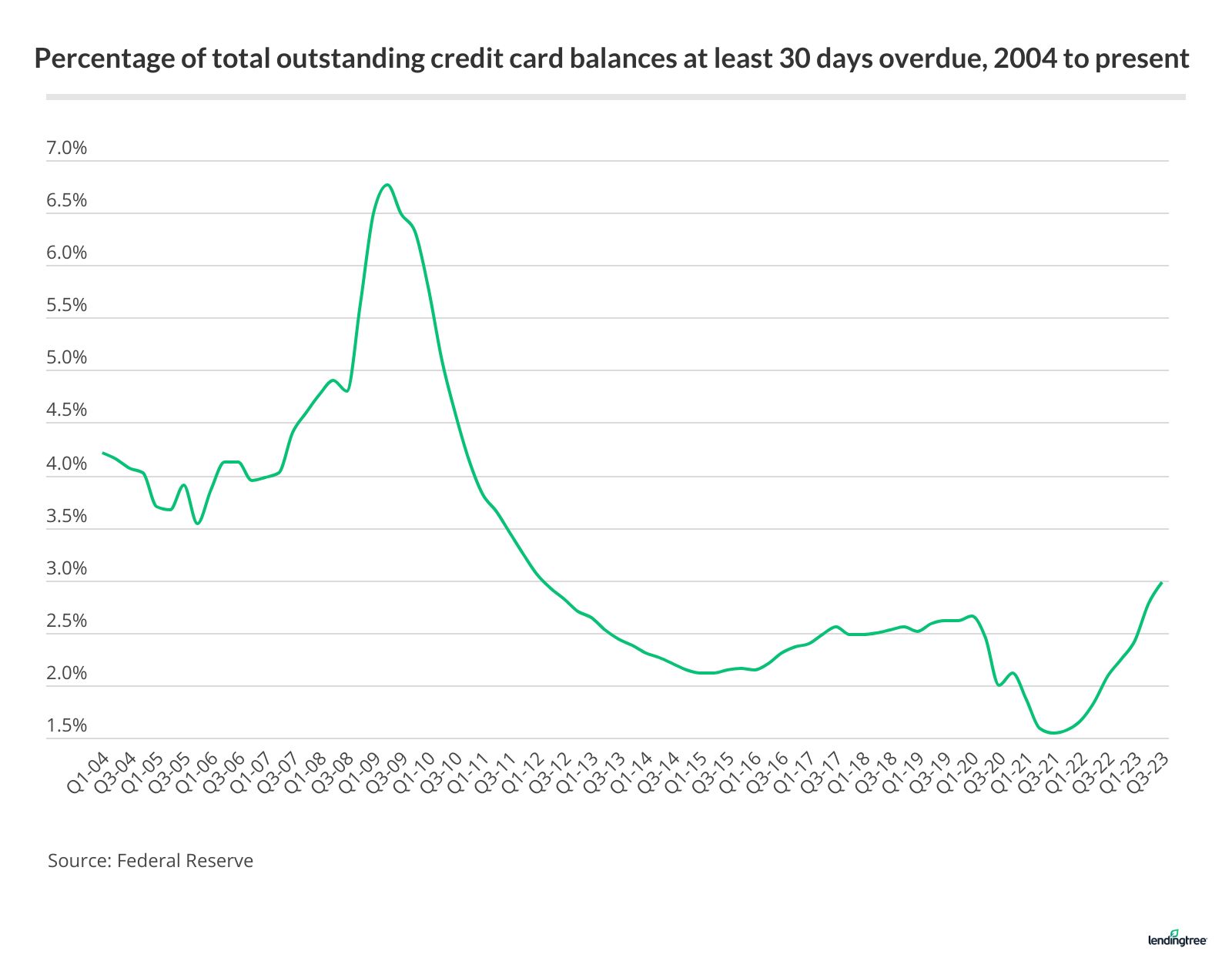2024 Credit Card Debt Statistics
Americans have an absolute mountain of credit card debt — $1.079 trillion, to be exact.
This credit card debt statistics page tracks Americans’ credit card use each month. We update this page regularly, looking at how much debt people have, how often they carry a balance month to month, how often they pay their credit card bills late and more.
How much credit card debt do Americans have?
This marks the second consecutive quarter in which Americans’ credit card balances topped $1 trillion, which had never happened prior to the second quarter of 2023. It also continues a trend of third-quarter credit card debt increases. With the exception of 2020, when the nation was in the depths of the COVID-19 pandemic, credit card debt hadn’t fallen during the third quarter of a year since 2011. That quarter was the last of 11 straight quarters — from Q1 2009 through Q3 2011 — to see a drop in credit card debt as the nation wrestled with the impact of the Great Recession.
With this latest increase, credit card balances have risen by $223 billion since the fourth quarter of 2021. Americans’ credit card debt is $152 billion higher than the record set in the fourth quarter of 2019, when balances stood at $927 billion. However, thanks to record interest rates, stubborn inflation and myriad other economic factors, credit card balances are likely only going to climb, at least in the near future.
These record balances are light years above the $478 billion seen more than 20 years ago in the first quarter of 1999.

Card debt showed hockey-stick growth until the financial collapse in 2008, when balances fell from $866 billion in the fourth quarter of 2008 to $660 billion in the first quarter of 2013. But, as you can see in the chart below, the hockey stick returned.
Then, when the pandemic took hold in 2020, credit card balances plunged again — from $927 billion in the fourth quarter of 2019 to $770 billion in the first quarter of 2021. But — again — the hockey stick returned, thanks to a massive spike in the fourth quarter of 2021.

Which states’ residents have the most credit card debt?
Credit cardholders in New Jersey have the highest average credit card debt of any state, according to LendingTree data, while those in Mississippi have the lowest.
LendingTree analysts reviewed anonymized credit report data from the third quarter of 2023 for more than 310,000 LendingTree users to calculate these averages and create a list of states with the most debt.
The eight states with the highest debt are all in the eastern U.S., with all but Maryland and Florida in the Northeast. Six of the seven with the lowest are in the South. There are major differences in the balances at the top and bottom of our rankings, with New Jersey cardholders owing $8,757 and Mississippi’s owing $5,658. That means the average New Jersey balance is 55% higher than the average balance in Mississippi.
What percentage of credit card accounts carry a balance?
Americans carried a balance on 56% of all active credit card accounts in the third quarter of 2022, according to the most recent available data from the American Bankers Association.

Job No. 1 for anyone with a credit card is to pay off that balance in full at the end of each month. But we all know that life happens, and that means that it’s not always possible to pay off your credit cards each month.
American Bankers Association data showed that more than half (56%) of all active accounts carried a balance in the third quarter of 2022, the most recent quarter for which we have data. That’s up 3 percentage points from the second quarter of 2022. Even with the recent increases, however, that percentage is still below pre-pandemic levels. For example, 60% of active accounts carried a balance in the first quarter of 2019 before falling throughout 2020 to as low as 51% in the second quarter of 2021.
If you look at all credit card accounts, the American Bankers Association data shows that 43% of accounts were active and carried a balance at some point in the third quarter of 2022, 34% of accounts were active but didn’t carry a balance and 23% of accounts were dormant for the quarter.
What’s the average interest rate on people’s credit cards? What about those who carry a balance? What about new credit card offers?
For all credit cards, the average APR in the third quarter of 2023 was 21.19%.
For cards accruing interest, the average in the third quarter of 2023 was 22.77%.
For new credit card offers, the average today is 24.59% — the highest since we began tracking rates monthly in 2019.
| Average APRs for new credit card offers and current card accounts | |
| Average APR for new credit card offers | 24.59% |
| Average APR for all current card accounts | 21.19% |
| Average APR for all accounts that accrue interest | 22.77% |
Sources: LendingTree data, Federal Reserve
The Federal Reserve’s G.19 consumer credit report showed that the average APR for all current credit card accounts jumped to 21.19% in the third quarter of 2023, up from 20.68% in the second quarter. Meanwhile, APRs for cards accruing interest shot up to 22.77%, up from 22.16% in the second quarter. According to the Fed, the average for all card accounts and those accruing interest are the highest since tracking began in 1994.
And as the chart below shows, the rate you’re offered can also vary widely based on the type of card for which you apply.
| Category | Minimum APR | Maximum APR | Average | Previous month |
|---|---|---|---|---|
| Average APR for all new card offers | 21.11% | 28.07% | 24.59% | 24.56% |
| 0% balance transfer cards | 18.74% | 27.86% | 23.30% | 23.30% |
| No-annual-fee cards | 20.61% | 27.71% | 24.16% | 24.15% |
| Rewards cards | 20.88% | 28.13% | 24.50% | 24.46% |
| Cash back cards | 21.04% | 27.79% | 24.42% | 24.33% |
| Travel rewards cards | 20.90% | 28.74% | 24.82% | 24.82% |
| Airline credit cards | 21.27% | 29.37% | 25.32% | 25.29% |
| Hotel credit cards | 21.73% | 29.43% | 25.58% | 25.58% |
| Low-interest credit cards | 13.69% | 22.52% | 18.11% | 18.11% |
| Grocery rewards cards | 20.53% | 28.16% | 24.35% | 24.35% |
| Gas rewards cards | 20.99% | 27.98% | 24.49% | 24.49% |
| Dining rewards cards | 20.69% | 28.47% | 24.58% | 24.56% |
| Student credit cards | 19.56% | 27.85% | 23.70% | 23.70% |
| Secured credit cards | 27.06% | 27.06% | 27.06% | 27.06% |
Source: LendingTree review of publicly available terms and conditions for about 200 U.S. credit cards.
Of course, your best move is to make those interest rates a moot point by paying your card debt in full, but that’s often easier said than done.
How many Americans are currently delinquent with their credit card payments?
Just 2.98% of Americans’ total outstanding credit card balances are currently at least 30 days delinquent.

According to the most recent delinquency data from the Fed, the 30-day delinquency rate (or the percentage of total outstanding credit card balances currently at least 30 days overdue) rose from 2.77% in the second quarter of 2023 to 2.98% in the third quarter of 2023.
That’s the eighth straight quarter of increases, pushing rates to the highest levels seen since the first quarter of 2012, when rates hit 3.06%. However, delinquency rates are still near historic lows. The average delinquency rate since the Fed began tracking in 1991 is 3.74%, while the average since 2000 is 3.46%.
Today’s numbers are also vastly different from what we saw during the Great Recession, when delinquencies peaked at nearly 7% in 2009 and stayed above 5% for nearly two years.
The content above is not provided by any issuer. Any opinions expressed are those of LendingTree alone and have not been reviewed, approved, or otherwise endorsed by any issuer. The offers and/or promotions mentioned above may have changed, expired, or are no longer available. Check the issuer's website for more details.
